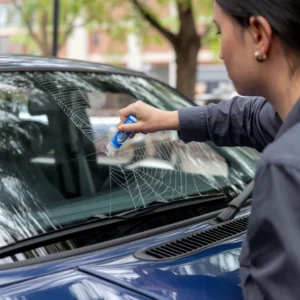Windshield Chip Repair | Quick Fixes for a Safer Drive Windshield chip repair is crucial...
Dealing with Inside Windshield Foggy Woes| Solutions and Tips
Inside windshield foggy is a common issue that drivers encounter, particularly in adverse weather conditions such as rain, snow, or high humidity. This occurrence can significantly impede visibility and pose a serious threat to road safety. The importance of maintaining a clear windshield for safe driving cannot be overstated. A foggy windshield hampers a driver’s ability to see the road, other vehicles, and potential hazards clearly, increasing the risk of accidents.
Why is my windshield fogging up on the inside?
Certainly! Fogging on the inside of your windshield can be caused by a variety of factors. Let’s break down the potential reasons:
Natural causes of inside windshield fog:
Temperature differences inside and outside the car:
- When there’s a significant temperature difference between the inside and outside of your car, condensation can occur on the interior surfaces, including the windshield. This is common during colder weather when warm air inside the vehicle comes into contact with the cold windshield.
Humidity levels in the environment:
- High humidity levels in the surrounding environment can contribute to condensation on the interior surfaces of the windshield, especially if the inside of the car is cooler than the outside.
Possible issues leading to persistent fogging:
Interior moisture accumulation:
- If there’s excess moisture inside the car, it can contribute to persistent fogging. Wet clothing, spilled liquids, or even improperly sealed windows can introduce moisture into the vehicle.
HVAC system problems:
- Issues with the Heating, Ventilation, and Air Conditioning (HVAC) system, such as a malfunctioning heater core or a clogged drain, can result in inadequate moisture control inside the car. This can lead to increased condensation on the windshield.
Leaks or seal issues:
- Leaks in the car’s interior or compromised seals around windows or doors can allow water to enter the vehicle. This water can contribute to high humidity levels inside, leading to persistent fogging.
To address these issues:
- Ensure that your car’s interior is kept dry. Remove wet items promptly and address any spills.
- Check for and fix any leaks in the vehicle’s interior.
- Maintain your HVAC system regularly. Replace cabin air filters and address any issues with the heating and cooling components.
- Use the defrost setting on your car’s ventilation system, as it helps to remove moisture from the air and prevent condensation.
Inside Windshield Foggy after Rain

Effects of Rain on Windshield Fog:
Rain can contribute to the fogging of the inside of a windshield due to several factors. When rainwater comes into contact with the exterior surface of the windshield, it can create a humid environment both inside and outside the vehicle. This increased humidity, combined with other factors, can lead to the formation of fog on the inside of the windshield.
Common Reasons for Post-Rain Fogging:
Water Residue Inside the Vehicle:
After rainfall, water may enter the vehicle, either through open windows, poorly sealed doors, or other entry points. If not properly dried or if there is residual water inside, it can contribute to fogging when the interior temperature changes.
Increased Humidity Post-Rainfall:
Rainfall often raises the overall humidity levels in the air. When this humid air enters the car and comes into contact with cooler surfaces, such as the interior of the windshield, it can lead to condensation and fog formation.
Steps to Address Inside Windshield Foggy Conditions After Rain:
To tackle foggy conditions on the inside of the windshield after rain, consider the following steps:
Dry Interior Surfaces:
- Thoroughly dry any wet surfaces inside the vehicle, including seats, floor mats, and carpets. Use towels or a wet-dry vacuum to remove excess moisture.
Ventilation:
- Ensure proper ventilation by using the car’s ventilation system. Turn on the defroster or set the air conditioning to a comfortable level to help reduce humidity inside the car.
Open Windows:
- If weather conditions permit, open the windows slightly to allow fresh air circulation. This can help in expelling humid air and reducing condensation on the windshield.
Use Defroster/Heater:
- Turn on the vehicle’s defroster or heater to warm up the interior. This helps to raise the temperature of the windshield, reducing the likelihood of condensation.
Check Seals and Windows:
- Inspect the vehicle’s windows, doors, and seals for any signs of damage or poor sealing. Repair or replace damaged components to prevent water from entering the car.
Use Anti-Fog Products:
- Apply anti-fog products to the interior surface of the windshield. These products can help minimize condensation and keep the glass clear.
How to Prevent Your Car from Fogging Up?
Preventing your car from fogging up involves a combination of regular maintenance practices, proper ventilation strategies, using moisture-absorbing products, and adopting parking strategies. Here’s a detailed guide:
Regular maintenance practices
Cleaning the interior surfaces:
- Regularly clean the inside of your car, especially windows, using a suitable glass cleaner. Dirty surfaces can attract and retain moisture, contributing to fogging.
Checking and fixing leaks:
- Inspect your car for any leaks, such as water entering through damaged door seals or windows. Fixing these leaks will prevent excess moisture from accumulating inside the vehicle.
Proper ventilation strategies
Proper use of defrosters:
- Use your car’s defroster setting to warm the windows. This helps evaporate moisture on the glass surfaces, reducing the likelihood of fogging.
Ventilation system settings:
- Ensure that your car’s ventilation system is working efficiently. Use the fresh air setting rather than recirculating air to promote air circulation and reduce humidity inside the vehicle.
Using moisture-absorbing products
Silica gel packs:
- Place silica gel packs in your car to absorb excess moisture. Replace them regularly or when they become saturated.
Moisture-absorbing bags:
- Hang moisture-absorbing bags, often containing activated charcoal or other desiccants, inside your car to help control humidity.
Parking strategies to minimize fogging
Crack windows slightly:
- Leave your windows slightly open to allow air circulation, preventing the buildup of humidity inside the car.
Choose shaded parking:
- Whenever possible, park your car in shaded areas to reduce the temperature difference between the inside and outside, minimizing the chances of condensation.
Use sunshades:
- Place reflective sunshades on your windshield to prevent the sun from heating the interior excessively, which can lead to condensation when the air cools.
Regularly air out your car:
- Open your windows when parked to allow fresh air to circulate and remove any trapped moisture.
Practical Solutions for Inside Windshield Foggy Situations

Immediate actions to clear fog:
Wiping down the windshield:
- Keep a microfiber cloth or a windshield cleaning solution in your car for quick wiping.
- Use long, horizontal strokes to clear the fog, starting from the driver’s side.
Using defrosters effectively:
- Turn on the defroster and ensure it’s set to the windshield setting.
- Activate the air conditioning along with the defroster to reduce humidity inside the car.
- Adjust the temperature to a warmer setting to speed up the process.
Long-term preventive measures:
Addressing underlying issues:
Check for leaks: Ensure there are no water leaks in the car, especially in the trunk or around the windshield. If you want professional guidance then Reliable Auto Glass is best in business.
Inspect the cabin air filter: A clogged or dirty cabin air filter can contribute to moisture buildup. Replace it regularly.
Maintain the HVAC system: Regularly service your heating, ventilation, and air conditioning (HVAC) system to ensure proper functioning.
Developing habits to minimize moisture inside the car:
Use moisture-absorbing products: Place moisture-absorbing products like silica gel, desiccant bags, or moisture absorbers inside the car, especially during periods of high humidity.
Ventilation: When possible, crack open a window slightly to allow fresh air circulation, reducing humidity inside the car.
Avoid wet items: If possible, avoid placing wet items like umbrellas or wet clothing inside the car. If unavoidable, make sure to dry them as soon as possible.
Conclusion
In conclusion, a foggy interior windshield poses a potential hazard for drivers, compromising visibility and overall road safety. The phenomenon of a foggy windshield often occurs due to a temperature difference between the inside and outside of the vehicle, leading to condensation on the glass surface. Feel free to contact us for any type of services or query like inside windshield foggy.
FAQs
Q: Why Does The Inside Of My Windshield Get Foggy?
A: Interior windshield fog is typically caused by a temperature difference between the inside and outside of your vehicle, leading to condensation on the glass. Factors such as high humidity, temperature changes, or trapped moisture inside the car contribute to this issue.
Q: How Can I Quickly Clear The Fog On The Inside Of My Windshield?
A: Utilize your vehicle’s defrost function, adjusting the temperature to a warmer setting. Ensure proper ventilation by using the defrost vents and directing airflow towards the windshield. Opening windows slightly can also help equalize the temperature.
Q: Are There Preventive Measures To Avoid Interior Windshield Fogging?
A: Yes, maintaining your vehicle’s HVAC system, checking for and addressing any leaks, and using anti-fog solutions on the interior glass surface can prevent or minimize interior windshield fog.
Q: Can Using Air Conditioning Help Prevent Interior Windshield Fog?
A: Yes, using the air conditioning system can help control humidity inside the vehicle, reducing the likelihood of fog formation. Make sure the AC system is in good working condition.
Q: What Should I Do If The Inside Of My Windshield Remains Foggy Despite Using The Defrost Function?
A: Check for any issues with your vehicle’s HVAC system, including clogged air filters or malfunctioning components. If problems persist, consult a professional mechanic for a thorough inspection.
Our Services
Our Latest Blogs
1986 Porsche 944 Sunroof Replacement | Expert Installation
1986 Porsche 944 Sunroof Replacement | Expert Installation 1986 Porsche 944 sunroof replacement is an...
Sunroof Seal Replacement | Say Goodbye to Water Leaks
Sunroof Seal Replacement | Say Goodbye to Water Leaks Sunroof seal replacement is essential for...
How to Stop My Windshield Crack from Spreading
How to Stop My Windshield Crack from Spreading How to stop my windshield crack from...





